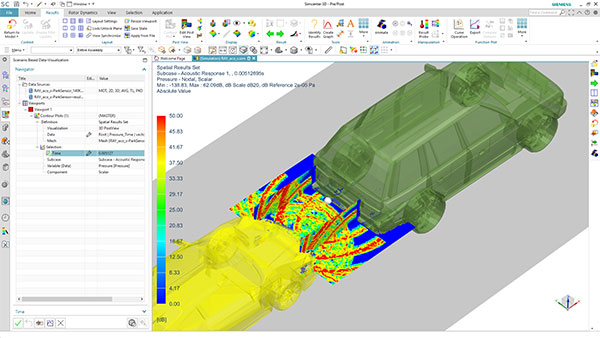Editor’s Pick: Improve Multiphysics Simulation for Design Space Exploration
Siemens Simcenter 3D Version 2020.1 is a unified work environment for collaborative multiphysics simulation.

Siemens Simcenter 3D 2020.1 extends the use of collaborative multiphysics simulation and design space exploration. Image courtesy of Siemens.
January 15, 2020
Siemens introduces the 2020.1 update of Simcenter 3D, a unified work environment for collaborative multiphysics simulation and design space exploration. Each quarterly update enhances portions of this unified portfolio, to keep improving without being disruptive.
In version 2020.1 the new features focus on four key areas:
- multidisciplinary integration;
- faster CAE processes;
- digital thread; and
- scalability.
New features in multidisciplinary integration deepen the types of analyses that can be achieved in several domains. Rotor dynamics now solves for linear and non-linear connection elements. Aeroelasticity flutter analysis is improved by use of the Simcenter Nastran solver and integration of the International Standard Atmosphere definitions. Also, there is now two-way fluid-structure interaction analysis, to solve problems like the relationship of lift-to-wing deformation.
Creating faster CAE processes is about more than streamlining software code for improved execution—it is about improving workflow. For example, Simcenter 3D Design Space Exploration can now work in tandem with Simcenter 3D Margin of Safety. Users can now simulate multiple design variants using both products.
The Noise, Vibration, Harshness (NVH) Composer has been simplified to interactively define full vehicle assembly layout for finite element NVH analysis. And it is now possible to create sets of model parameters for motion studies, reducing the redundancy of creating multiple models with similar data for each.
To improve digital thread connections, Simcenter 3D 2020.1 has new tools for test/analysis correlation for pre-test planning. This allows analysts and test engineers to use the same data. There is also an increased ability to identify load issues at attachment or connection locations, such as for transfer path analysis.
Siemens wants Simcenter to be an open analysis environment compatible with a wide range of tools and services. New in 2020.1 is support for cyclic symmetry from the Dassault Systèmes Abaqus solver environment. This makes it easier to set up for cyclic boundary conditions for pre-processing, and to post-process an Abaqus ODB file to plot contour and animation results for a single sector or any number of sectors.
There is also new on-demand access to Simcenter 3D on the Cloud, in conjunction with cloud services developer Rescale. This new relationship will be especially helpful to small and medium-sized businesses.
The 2020.1 update to Simcenter 3D is now available directly from Siemens.
For more information on the 2020.1 update to Siemens Simcenter 3D, click here.
A video introducing the new release is here.
Sources: Press materials received from the company and additional information gleaned from the company’s website.
More Siemens Digital Industries Software Coverage
Subscribe to our FREE magazine, FREE email newsletters or both!
About the Author
DE’s editors contribute news and new product announcements to Digital Engineering.
Press releases may be sent to them via [email protected].






